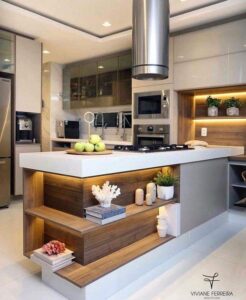Stainless Steel Interior Design By Karvi Interio

In the world of interior design, stainless steel stands out as a material that combines durability, aesthetic appeal, and functionality. Its sleek, modern appearance and practical benefits make it a popular choice for a range of interior applications. This in-depth guide will explore the diverse uses of stainless steel in interior design, its advantages, and how you can incorporate it into your home to create a contemporary and stylish environment.
Stainless Steel Interior Design
1. Introduction to Stainless Steel in Interior Design
What Is Stainless Steel?
Stainless steel is an alloy primarily composed of iron, carbon, and chromium. The addition of chromium gives it its unique properties: resistance to rust, corrosion, and staining. Stainless steel is available in various finishes, such as polished, brushed, and matte, which offer different visual effects and levels of shine. Its strength and low-maintenance qualities make it an ideal choice for both functional and decorative applications in modern interiors.
The Appeal of Stainless Steel
1. Sleek and Modern Look: Stainless steel’s reflective surface and clean lines contribute to a sophisticated and contemporary look. Its versatility allows it to blend seamlessly with various design styles, from minimalist to industrial.
2. Durability: Known for its resilience, stainless steel can withstand heavy use and exposure to elements without showing signs of wear and tear. This makes it a practical choice for high-traffic areas and frequently used surfaces.
3. Hygiene and Maintenance: The non-porous surface of stainless steel resists bacteria and is easy to clean. Regular maintenance involves simple wiping, making it a hygienic option for spaces like kitchens and bathrooms.
4. Versatility: Stainless steel’s adaptability means it can be used in a wide range of applications, from furniture and fixtures to decorative elements, enhancing its utility in interior design.
2. Applications of Stainless Steel in Interior Design
Kitchen Design
1. Cabinets and Storage Solutions
Stainless steel cabinets offer a sleek, modern look and are built to last. They are resistant to stains and scratches, making them ideal for busy kitchens. Stainless steel can be used for both upper and lower cabinets, creating a cohesive and contemporary look. Additionally, its reflective surface can help brighten up the kitchen space by reflecting light.
2. Countertops
Stainless steel countertops are a popular choice for modern kitchens due to their durability and heat resistance. They are easy to clean, which is crucial in a space where spills and stains are common. Stainless steel countertops also complement a variety of other materials, such as wood or stone, adding to their versatility.
3. Backsplashes
A stainless steel backsplash can create a striking visual contrast against other kitchen elements. It reflects light, which can make a small kitchen feel more spacious and bright. Stainless steel backsplashes are also easy to maintain and keep clean, as they are resistant to moisture and stains.
4. Appliances
Stainless steel appliances, including refrigerators, ovens, and dishwashers, are widely used in modern kitchens. Their sleek appearance and durability make them a popular choice. When paired with stainless steel cabinets and countertops, these appliances create a unified and stylish kitchen design.
Bathroom Design
1. Fixtures and Fittings
In bathrooms, stainless steel is often used for fixtures and fittings such as faucets, showerheads, towel bars, and toilet paper holders. Its resistance to water and moisture makes it an ideal material for these elements, ensuring they remain in good condition despite the humid environment.
2. Vanities and Cabinets
Stainless steel vanities and cabinets offer a contemporary look and practical benefits. They are resistant to water damage and stains, making them suitable for bathroom environments. The sleek appearance of stainless steel can also help create a modern, clean-lined aesthetic.
3. Shower Doors and Partitions
Stainless steel is frequently used for shower doors and partitions due to its durability and resistance to rust. The material’s modern look adds to the overall design of the bathroom, while its strength ensures long-lasting performance.
Living and Dining Areas
1. Furniture
In living and dining areas, stainless steel furniture such as tables, chairs, and shelving units adds a touch of sophistication and modernity. Stainless steel’s reflective surface can also help brighten up the room and create a sense of openness. Its durability ensures that the furniture will withstand regular use and maintain its appearance over time.
2. Railings and Balustrades
Stainless steel railings and balustrades are commonly used in staircases, balconies, and glass partitions. They offer a clean, modern look and provide safety while adding to the aesthetic appeal of the space. The material’s resistance to corrosion ensures that the railings will remain in good condition, even in high-humidity environments.
3. Decorative Accents
Stainless steel can be used in various decorative accents, including wall panels, art pieces, and light fixtures. Its versatility allows for creative design solutions that can enhance the overall look of a room. The material’s reflective quality can also be used to highlight certain features and create visual interest.
Flooring and Wall Panels
1. Flooring
While less common, stainless steel flooring can be used in specific design contexts, such as in commercial spaces or high-end residences. Stainless steel flooring is durable and resistant to damage, making it suitable for areas with heavy foot traffic. It also adds a sleek, modern touch to the interior design.
2. Wall Panels
Stainless steel wall panels can create a dramatic visual effect and add a contemporary element to a room. They are often used in commercial spaces or as feature walls in residential settings. The material’s reflective surface can make a room appear larger and more open.
3. Design Tips for Incorporating Stainless Steel
Balance and Contrast
1. Pairing with Other Materials: Stainless steel works well with a variety of other materials, such as wood, glass, and stone. Combining stainless steel with warmer materials like wood can create a balanced and inviting space. For example, a stainless steel kitchen can be complemented with wooden cabinets or countertops to add warmth and texture.
2. Creating Contrast: Use stainless steel to create contrast with other design elements. For instance, a stainless steel backsplash can stand out against dark cabinetry or colorful walls. The reflective quality of stainless steel also helps to highlight and enhance other design features.
Finishes and Textures
1. Choosing the Right Finish: Stainless steel is available in various finishes, including polished, brushed, and matte. Each finish offers a different visual effect and level of shine. Polished stainless steel provides a high-gloss look, while brushed or matte finishes offer a more subdued appearance. Choose the finish that best complements the overall design of your space.
2. Combining Textures: Incorporate different textures to add depth and interest to your design. For example, pair stainless steel with textured wall panels or soft textiles to create a dynamic and layered look.
Lighting and Reflection
1. Utilizing Natural Light: Stainless steel’s reflective surface can help enhance natural light in a room. Position stainless steel elements where they can capture and reflect sunlight, making the space feel brighter and more open.
2. Adding Artificial Lighting: Integrate artificial lighting to highlight stainless steel features. For instance, use under-cabinet lighting to illuminate stainless steel countertops or incorporate spotlights to accentuate stainless steel artwork or wall panels.
4. Maintenance and Care
Cleaning Stainless Steel
1. Regular Cleaning: Stainless steel surfaces should be cleaned regularly to maintain their appearance. Use a soft cloth or microfiber cloth to wipe down surfaces, and avoid abrasive cleaners or scrubbing pads that can scratch the material.
2. Using Cleaning Solutions: For routine cleaning, use a mild detergent or a solution of water and vinegar. Apply the cleaner to a cloth and wipe the surface in the direction of the grain. Rinse with clean water and dry with a soft cloth to prevent water spots.
3. Removing Stains: For tougher stains or fingerprints, use a specialized stainless steel cleaner. Apply the cleaner according to the manufacturer’s instructions and wipe the surface with a clean cloth.
Preventing Damage
1. Avoiding Harsh Chemicals: Refrain from using harsh chemicals or bleach on stainless steel, as they can damage the surface. Stick to gentle cleaning solutions and avoid abrasive materials.
2. Preventing Scratches: Be cautious with items that may scratch the stainless steel surface. Avoid dragging heavy or sharp objects across the surface, and use protective mats or pads when placing items on stainless steel countertops or floors.
5. Cost Considerations
Factors Affecting Cost
1. Material Quality: The cost of stainless steel can vary based on the quality and grade of the material. Higher-grade stainless steel, such as 316L, is more resistant to corrosion and may be more expensive than standard grades.
2. Design and Customization: Custom-designed stainless steel elements or intricate patterns will typically cost more than standard options. The complexity of the design and the level of customization will impact the overall cost.
3. Installation Costs: Professional installation may add to the cost of stainless steel elements. Hiring a skilled installer ensures that the material is properly fitted and that the final result meets your expectations.
Budgeting Tips
1. Set a Budget: Determine your budget for incorporating stainless steel into your interior design. Consider the costs of materials, customization, and installation to ensure that you stay within your financial limits.
2. Compare Options: Research different suppliers and contractors to find the best value for your money. Compare prices and reviews to ensure that you are getting high-quality materials and services.
6. Real-Life Examples of Stainless Steel Interior Design
Case Study 1: Modern Urban Loft
In a modern urban loft, stainless steel was used to create a sleek and industrial look. Stainless steel cabinets, countertops, and appliances were incorporated into the kitchen design, while stainless steel railings and light fixtures added to the overall aesthetic. The result was a cohesive and stylish space that embraced the contemporary urban vibe.
Case Study 2: Luxury Bathroom Renovation
For a luxury bathroom renovation, stainless steel was used for fixtures, vanities, and shower doors. The material’s modern look complemented the high-end finishes, such as marble tiles and custom cabinetry. The stainless steel elements added a touch of sophistication and ensured durability in the bathroom environment.
Case Study 3: Contemporary Office Space
In a contemporary office space, stainless steel was used for furniture, wall panels, and decorative accents. The material’s reflective quality helped to brighten the space and create a professional, polished look. Stainless steel shelving and desks provided functionality while contributing to the modern design.
7. Conclusion: Embracing Stainless Steel in Interior Design
Stainless steel offers a unique combination of modern elegance, durability, and versatility, making it an excellent choice for a wide range of interior design applications. From kitchens and bathrooms to living spaces and decorative accents, stainless steel can enhance the aesthetic and functionality of any room. By understanding the benefits, applications, and design considerations of stainless steel, you can make informed decisions about how to incorporate this versatile material into your home. Whether you’re renovating an existing space or designing a new one, stainless steel can help you achieve a contemporary and stylish look that stands the test of time.

